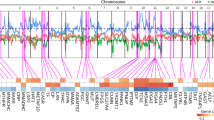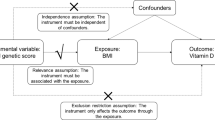Abstract
Objective:
To explore the influence of gender, together with folate status, on the relation between the common methylenetetrahydrofolate reductase (MTHFR) C677T polymorphism and plasma total homocysteine (tHcy) concentrations in healthy children.
Design:
Cross-sectional study by face-to-face interview.
Setting and subjects:
A total of 186 sixth-grade students participated from twelve randomly selected primary schools in Volos, Greece.
Methods:
Fasting tHcy, folate, and vitamin B12 were measured in plasma. The MTHFR genotypes were determined. Anthropometric and dietary intake data by 24-h recall were collected.
Results:
Geometric means for plasma tHcy, plasma folate and energy-adjusted dietary folate did not differ between females and males. The homozygous mutant TT genotype was associated with higher tHcy only in children with lower plasma folate concentrations (<19.9 nmol/l, P=0.012). As a significant gender interaction was observed (P=0.050), we stratified the lower plasma folate group by gender and found that the association between the genotype and tHcy was restricted to males (P=0.026). Similar results were obtained when folate status was based on estimated dietary folate. Specifically, only TT males that reported lower dietary folate consumption (<37 μg/MJ/day) had tHcy that was significantly higher than tHcy levels of C-allele carriers (P=0.001).
Conclusions:
Under conditions of lower folate status (as estimated by either plasma concentration or reported dietary consumption), gender modifies the association of the MTHFR(C677T) polymorphism with tHcy concentrations in healthy children.
Sponsorship:
Kellog Europe.
This is a preview of subscription content, access via your institution
Access options
Subscribe to this journal
Receive 12 print issues and online access
$259.00 per year
only $21.58 per issue
Buy this article
- Purchase on Springer Link
- Instant access to full article PDF
Prices may be subject to local taxes which are calculated during checkout
Similar content being viewed by others
References
Alfthan G, Laurinen MS, Valsta LM, Pastinen T, Aro A (2003). Folate intake, plasma folate and homocysteine status in a random Finnish population. Eur J Clin Nutr 57, 81–88.
Bates CJ, Mansoor MA, Gregory J, Pentiev K, Prentice A (2002). Correlates of plasma homocysteine, cysteine and cysteinyl-glycine in respondents in the British National Diet and Nutrition Survey of young people aged 4–18 years, and a comparison with the survey of people aged 65 years and over. Br J Nutr 87, 71–79.
Bjorke Monsen AL, Ueland PM (2003). Homocysteine and methylmalonic acid in diagnosis and risk assessment from infancy to adolescence. Am J Clin Nutr 78, 7–21.
Block G (1982). A review of validations of dietary assessment methods. Am J Epidemiol 115, 492–505.
Boushey CJ, Beresford SA, Omenn GS, Motulsky AG (1995). A quantitative assessment of plasma homocysteine as a risk factor for vascular disease. Probable benefits of increasing folic acid intakes. JAMA 274, 1049–1057.
Brattstrom L, Lindgren A, Israelsson B, Andersson A, Hultberg B (1994). Homocysteine and cysteine: determinants of plasma levels in middle-aged and elderly subjects. J Intern Med 236, 633–641.
Brouwer IA, van Dusseldorp M, West CE, Meyboom S, Thomas CM, Duran M et al. (1999). Dietary folate from vegetables and citrus fruit decreases plasma homocysteine concentrations in humans in a dietary controlled trial. J Nutr 129, 1135–1139.
Cappuccio FP, Bell R, Perry IJ, Gilg J, Ueland PM, Refsum H et al. (2002). Homocysteine levels in men and women of different ethnic and cultural background living in England. Atherosclerosis 164, 95–102.
Chango A, Potier De Courcy G, Boisson F, Guilland JC, Barbe F, Perrin MO et al. (2000). 5,10-methylenetetrahydrofolate reductase common mutations, folate status and plasma homocysteine in healthy French adults of the Supplementation en Vitamines et Mineraux Antioxydants (SU.VI.MAX) cohort. Br J Nutr 84, 891–896.
De Laet C, Wautrecht JC, Brasseur D, Dramaix M, Boeynaems JM, Decuyper J et al. (1999). Plasma homocysteine concentration in a Belgian school-age population. Am J Clin Nutr 69, 968–972.
Dekou V, Whincup P, Papacosta O, Ebrahim S, Lennon L, Ueland PM et al. (2001). The effect of the C677T and A1298C polymorphisms in the methylenetetrahydrofolate reductase gene on homocysteine levels in elderly men and women from the British regional heart study. Atherosclerosis 154, 659–666.
Dierkes J, Jeckel A, Ambrosch A, Westphal S, Luley C, Boeing H (2001). Factors explaining the difference of total homocysteine between men and women in the European Investigation Into Cancer and Nutrition Potsdam study. Metabolism 50, 640–645.
Ford ES, Smith SJ, Stroup DF, Steinberg KK, Mueller PW, Thacker SB (2002). Homocyst(e)ine and cardiovascular disease: a systematic review of the evidence with special emphasis on case–control studies and nested case–control studies. Int J Epidemiol 31, 59–70.
Frank GC, Berenson GS, Schilling PE, Moore MC (1977). Adapting the 24-h recall for epidemiologic studies of school children. J Am Diet Assoc 71, 26–31.
Frosst P, Blom HJ, Milos R, Goyette P, Sheppard CA, Matthews RG et al. (1995). A candidate genetic risk factor for vascular disease: a common mutation in methylenetetrahydrofolate reductase. Nat Genet 10, 111–113.
Gilfix BM, Blank DW, Rosenblatt DS (1997). Novel reductant for determination of total plasma homocysteine. Clin Chem 43, 687–688.
Giltay EJ, Hoogeveen EK, Elbers JMH, Gooren LJG, Asscheman H, Stehouwer CDA (1998). Effects of sex steroids on plasma total homocysteine levels: a study in transsexual males and females. J Clin Endocrinol Metab 83, 550–553.
Gregory III JF (1997). Bioavailability of folate. Eur J Clin Nutr 51 (Suppl 1), S54–S59.
Gudnason V, Stansbie D, Scott J, Bowron A, Nicaud V, Humphries S (1998). C677T (thermolabile alanine/valine) polymorphism in methylenetetrahydrofolate reductase (MTHFR): its frequency and impact on plasma homocysteine concentration in different European populations. EARS group. Atherosclerosis 136, 347–354.
Hague WM (2003). Homocysteine and pregnancy. Best Practice Res Clin Obstet Gynaecol 17, 459–469.
Ho CH (2000). The influence of age, sex, vitamin B(12), folate levels and methylenetetrahydrofolate reductase C677T genetic mutations on plasma homocysteine in the Chinese population. Haematologica 85, 1051–1054.
Husemoen LL, Thomsen TF, Fenger M, Jorgensen HL, Jorgensen T (2003). Contribution of thermolabile methylenetetrahydrofolate reductase variant to total plasma homocysteine levels in healthy men and women. Inter99 (2). Genet Epidemiol 24, 322–330.
Jacques PF, Bostom AG, Williams RR, Ellison RC, Eckfeldt JH, Rosenberg IH et al. (1996). Relation between folate status, a common mutation in methylenetetrahydrofolate reductase, and plasma homocysteine concentrations. Circulation 93, 7–9.
McLean RR, Jacques PF, Selhub J, Tucker KL, Samelson EJ, Broe KE et al. (2004). Homocysteine as a predictive factor for hip fracture in older persons. N Engl J Med 350, 2042–2049.
Miller SA, Dykes DD, Polesky HF (1988). A simple salting out procedure for extracting DNA from human nucleated cells. Nucleic Acids Res 16, 1215.
Molloy AM (2004). Folate and homocysteine interrelationships including genetics of the relevant enzymes. Curr Opin Lipidol 15, 49–57.
Morris MS, Jacques PF, Selhub J, Rosenberg IH (2000). Total homocysteine and estrogen status indicators in the Third National Health and Nutrition Examination Survey. Am J Epidemiol 152, 140–148.
Nicklas TA (1995). Dietary studies of children: the Bogalusa Heart Study experience. J Am Diet Assoc 95, 1127–1133.
Papoutsakis C, Yiannakouris N, Manios Y, Papaconstantinou E, Magkos F, Schulpis KH et al. (2005). Plasma homocysteine concentrations in greek children are influenced by an interaction between the methylenetetrahydrofolate reductase C677T genotype and folate status. J Nutr 135, 383–388.
Rea IM, McMaster D, Woodside JV, Young IS, Archbold GPR, Linton T et al. (2000). Community-living nonagenarians in Northern Ireland have lower plasma homocysteine but similar methylenetetrahydrofolate reductase thermolabile genotype prevalence compared to 70–89-year-old subjects. Atherosclerosis 149, 207–214.
Russo GT, Friso S, Jacques PF, Rogers G, Cucinotta D, Wilson PWF et al. (2003). Age and gender affect the relation between methylenetetrahydrofolate reductase C677T genotype and fasting plasma homocysteine concentrations in the framingham offspring study cohort. J Nutr 133, 3416–3421.
Schwartz SM, Siscovick DS, Malinow MR, Rosendaal FR, Beverly RK, Hess DL et al. (1997). Myocardial infarction in young women in relation to plasma total homocysteine, folate, and a common variant in the methylenetetrahydrofolate reductase gene. Circulation 96, 412–417.
Selhub J (1999). Homocysteine metabolism. Annu Rev Nutr 19, 217–246.
Selhub J, Jacques PF, Rosenberg IH, Rogers G, Bowman BA, Gunter EW et al. (1999). Serum total homocysteine concentrations in the third National Health and Nutrition Examination Survey (1991–1994): population reference ranges and contribution of vitamin status to high serum concentrations. Ann Intern Med 131, 331–339.
Selhub J, Jacques PF, Wilson PW, Rush D, Rosenberg IH (1993). Vitamin status and intake as primary determinants of homocysteinemia in an elderly population. JAMA 270, 2693–2698.
Seshadri S, Beiser A, Selhub J, Jacques PF, Rosenberg IH, D'Agostino RB et al. (2002). Plasma homocysteine as a risk factor for dementia and Alzheimer's disease. N Engl J Med 346, 476–483.
Spotila LD, Jacques PF, Berger PB, Ballman KV, Ellison RC, Rozen R (2003). Age dependence of the influence of methylenetetrahydrofolate reductase genotype on plasma homocysteine level. Am J Epidemiol 158, 871–877.
Stein JH, McBride PE (1998). Hyperhomocysteinemia and atherosclerotic vascular disease: pathophysiology, screening, and treatment. Arch Intern Med 158, 1301–1306.
Stone EJ, Osganian SK, McKinlay SM, Wu MC, Webber LS, Luepker RV et al. (1996). Operational design and quality control in the CATCH multicenter trial. Prev Med 25, 384–399.
Trichopoulou A (1992). Food Composition Tables and Greek Cooked Food and Dishes. School of Public Health: Athens.
Ubbink JB, Hayward Vermaak WJ, Bissbort S (1991). Rapid high-performance liquid chromatographic assay for total homocysteine levels in human serum. J Chromatogr 565, 441–446.
Wang XL, Duarte N, Cai H, Adachi T, Sim AS, Cranney G et al. (1999). Relationship between total plasma homocysteine, polymorphisms of homocysteine metabolism related enzymes, risk factors and coronary artery disease in the Australian hospital-based population. Atherosclerosis 146, 133–140.
Acknowledgements
The study was supported by a research grant from Kellogg Europe. We thank Dr Demosthenes B Panagiotakos for providing expert statistical guidance and laboratory staff Dr Aikaterini Skenderi for her assistance in biochemical analyses. We would like to acknowledge Ioanna Piperkou, Andrianna Cimponerio, Kyriakos Aloumanis, Alexandra Papathoma, Fotini Arvaniti, Crystallia Kolia, Natassa Zerva, Theodora E Sialvera, Dimitra Christou, Vassia Papakitsou, Anastasia Anastasiadou, and Georgia Felliou for their excellent assistance during data collection. The authors have no conflict of interest that is related to this manuscript.
Author information
Authors and Affiliations
Corresponding author
Additional information
Guarantor: C Papoutsakis.
Contributors: CP had the original idea, analyzed the data, wrote the first draft, and edited subsequent versions. NY: analyzed the data, and edited the manuscript, YM: coordinated data collection, and edited the manuscript, EP: supervised HPLC and RIA analyses, and edited the manuscript, FM: participated in field measurements, and edited the manuscript, KHS: participated in HPLC analyses, and edited the manuscript, AZ: supervised the field data collection, and edited the manuscript, and ALM: supervised the study, and edited the manuscript.
Rights and permissions
About this article
Cite this article
Papoutsakis, C., Yiannakouris, N., Manios, Y. et al. The effect of MTHFR(C677T) genotype on plasma homocysteine concentrations in healthy children is influenced by gender. Eur J Clin Nutr 60, 155–162 (2006). https://doi.org/10.1038/sj.ejcn.1602280
Received:
Revised:
Accepted:
Published:
Issue Date:
DOI: https://doi.org/10.1038/sj.ejcn.1602280
Keywords
This article is cited by
-
Association of methylenetetrahydrofolate reductase C677T and A1298C polymorphisms with myocardial infarction in Tunisian young patients
Comparative Clinical Pathology (2014)
-
Genetic polymorphisms modulate the folate metabolism of Brazilian individuals with Down syndrome
Molecular Biology Reports (2012)



